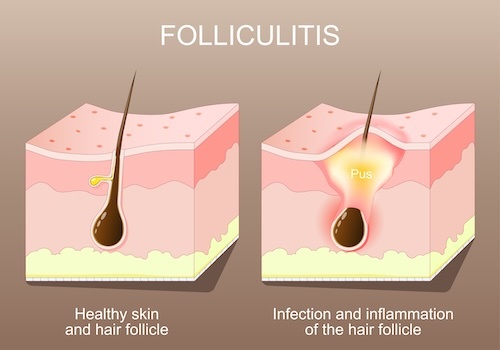Understanding Folliculitis and Mollenol
24th Jun 2025
 Folliculitis is a common skin condition characterized by inflammation of the hair follicles, often caused by bacterial (most commonly Staphylococcus aureus) or fungal infections[1][2][3]. It typically appears as clusters of small red or white bumps, sometimes filled with pus, and can be itchy, sore, or tender[1][4][5][3]. While mild cases often resolve on their own, more severe or recurrent cases may require medical treatment to prevent complications such as scarring or deeper infections[1][5][2].
Folliculitis is a common skin condition characterized by inflammation of the hair follicles, often caused by bacterial (most commonly Staphylococcus aureus) or fungal infections[1][2][3]. It typically appears as clusters of small red or white bumps, sometimes filled with pus, and can be itchy, sore, or tender[1][4][5][3]. While mild cases often resolve on their own, more severe or recurrent cases may require medical treatment to prevent complications such as scarring or deeper infections[1][5][2].
Clove Oil and Its Properties
Clove oil is derived from the clove plant and is known for its strong antibacterial, antifungal, and anti-inflammatory properties[6][7][8][9]. The primary active compound, eugenol, is responsible for much of its antimicrobial activity, effective against both Gram-positive and Gram-negative bacteria as well as certain fungi[7][8][9].
Using Mollenol for Folliculitis
Potential Benefits:
- Mollenol’s primary ingredients are clove bud oil (rich in eugenol), coconut oil (source of lauric acid), and sandalwood oil (santalol), all chosen for their natural antiviral, antimicrobial, and anti-inflammatory properties
- Clove oil’s antibacterial and antifungal effects may help reduce the microbial load contributing to folliculitis, particularly in mild cases[6][7][10][11][9].
- Its anti-inflammatory properties can help soothe inflamed and irritated skin, potentially reducing redness, swelling, and itching[6][8][9].
How to Use:
- Clove oil should always be diluted before application to the skin, as it can be very irritating or cause allergic reactions if used undiluted[6][11][8][9].
- A common method is to mix a few drops of clove oil with a carrier oil (such as coconut or jojoba oil) or with aloe vera gel before applying to the affected area[6][11][9].
- For example, diluting 5 drops of clove oil in 3 tablespoons of aloe vera gel is one suggested preparation for skin application[6].
- Apply the diluted mixture to clean skin, focusing on the affected areas, and monitor for any signs of irritation.
- Mollenol is ready to use, expertly researched and manufactured to the highest standards.
Precautions:
- If folliculitis worsens, spreads, or does not improve, seek medical advice, as prescription treatments may be necessary[1][5][2].
Summary Table: Clove Oil for Folliculitis
|
Aspect |
Clove Oil Use for Folliculitis, Mollenol and its uses |
|
Antimicrobial action |
|
|
Anti-inflammatory |
|
|
Application method |
|
|
Safety |
|
|
Medical advice |
- https://www.mayoclinic.org/diseases-conditions/folliculitis/symptoms-causes/syc-20361634
- https://www.medicalnewstoday.com/articles/318551
- https://www.healthline.com/health/folliculitis
- https://my.clevelandclinic.org/health/diseases/17692-folliculitis
- https://patient.info/skin-conditions/skin-rashes/folliculitis
- https://www.anveya.com/blogs/top-tips/what-to-dilute-clove-oil-with-for-skin-and-haircare
- https://pmc.ncbi.nlm.nih.gov/articles/PMC3769004/
- https://nikura.com/blogs/essential-oils/benefits-and-uses-of-clove-oil
- https://root2tip.co.uk/blogs/press/benifits-of-clove-water-and-oil-for-hairloss-and-skin-conditions-a-guide
- https://sadhev.com/blogs/journal/the-benefits-of-clove-oil-for-healthy-hair
- https://skinkraft.com/blogs/articles/scalp-folliculitis
